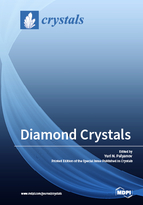Diamond Crystals
A special issue of Crystals (ISSN 2073-4352). This special issue belongs to the section "Inorganic Crystalline Materials".
Deadline for manuscript submissions: closed (30 June 2017) | Viewed by 91493
Special Issue Editor
2. Geology Geophysics Department, Novosibirsk State University, 630090 Novosibirsk, Russia
Interests: synthetic and natural diamonds; diamond synthesis and growth; high pressure high temperature; experimental modelling of natural diamond formation; diamond mineralogy; diamond properties and applications
Special Issues, Collections and Topics in MDPI journals
Special Issue Information
Dear Colleagues,
Diamonds, which possess a remarkable range of extreme and outstanding properties superior to other materials, have been attracting huge interest as a versatile and technologically useful material. Advances in diamond synthesis and growth techniques have paved the way for this unique material to many existent and prospective applications, which now range from optics and electronics to biomedicine and quantum computing. Besides its importance as the strategic future of electronic material, diamond has been the classical model object of fundamental research in solid-state physics, chemistry and engineering. Diamond occupies a very special place in the Earth sciences, where it serves as an invaluable source of information about the Earth’s interior. And, of course, being the king of gems, diamond is the key stone for the gem industry and gemmological science.
We invite researchers to contribute to the Special Issue on “Diamond Crystals”, which is intended to serve as a unique multidisciplinary forum covering broad aspects of science, technology and the application of synthetic and natural diamonds.
The potential topics include, but are not limited to:
- Synthesis and growth of diamond crystals
- Genesis of natural diamond
- Diamond morphology
- Real structure and properties of synthetic and natural diamond
- Characterisation of diamond by spectroscopic, microscopic and other advanced techniques
- Exploitation of the remarkable properties of diamond in various existent and emerging applications
Dr. Yuri N. Palyanov
Guest Editors
Manuscript Submission Information
Manuscripts should be submitted online at www.mdpi.com by registering and logging in to this website. Once you are registered, click here to go to the submission form. Manuscripts can be submitted until the deadline. All submissions that pass pre-check are peer-reviewed. Accepted papers will be published continuously in the journal (as soon as accepted) and will be listed together on the special issue website. Research articles, review articles as well as short communications are invited. For planned papers, a title and short abstract (about 100 words) can be sent to the Editorial Office for announcement on this website.
Submitted manuscripts should not have been published previously, nor be under consideration for publication elsewhere (except conference proceedings papers). All manuscripts are thoroughly refereed through a single-blind peer-review process. A guide for authors and other relevant information for submission of manuscripts is available on the Instructions for Authors page. Crystals is an international peer-reviewed open access monthly journal published by MDPI.
Please visit the Instructions for Authors page before submitting a manuscript. The Article Processing Charge (APC) for publication in this open access journal is 2600 CHF (Swiss Francs). Submitted papers should be well formatted and use good English. Authors may use MDPI's English editing service prior to publication or during author revisions.
Keywords
-
Diamond crystals
-
Diamond growth and synthesis
-
High Pressure High Temperature (HPHT)
-
Chemical Vapour Deposition (CVD)
-
Natural diamond
-
Diamond properties
-
Characterization
-
Diamond applications
Related Special Issue
- Diamond Crystals Volume II in Crystals (5 articles)






